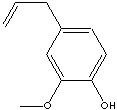PRODUCT IDENTIFICATION

H.S. CODE
TOXICITY
Eugenol ; Eugenic acid; p-Allylguaiacol; p-Eugenol;
2-Methoxy-4-(2-propenyl)phenol; Allylguaiacol; 1,3,4-Eugenol; 1-Hydroxy-2-methoxy-4-allylbenzene; 1-Hydroxy-2-methoxy-4-prop-2-enylbenzene; 1-Hydroxy-2-methoxy-4-propenylbenzene; 2-Methoxy-1-hydroxy-4-allylbenzene; 2-Methoxy-4-(2-propen-1-yl)phenol; 2-Methoxy-4-allylphenol; 2-Methoxy-4-prop-2-enylphenol; 2-Metoksy-4-allilofenol; 4-Allyl-1-hydroxy-2-methoxybenzene; 4-Allyl-2-methoxyphenol; 4-Allylcatechol 2-methyl ether; 4-Allylcatechol-2-methyl ether; 4-Allylguaiacol; 4-Hydroxy-3-methoxy-1-allylbenzene; 4-Hydroxy-3-methoxyallylbenzene; 5-Allylguaiacol; Allylguaiacol; Caryophyllic acid;
CLASSIFICATION
EXTRA NOTES
Overall Carcinogenic Evaluation: Group 3
A cinnamate derivative of the shikamate pathway found in clove oil and other plants.
EPA Pesticide Chemical Code 102701
PHYSICAL AND CHEMICAL PROPERTIES
MELTING POINT
SOLUBILITY IN WATER
SOLVENT SOLUBILITY
AUTOIGNITION
NFPA RATINGS
REFRACTIVE INDEX
> 104 C
EXTERNAL LINKS & GENERAL DESCRIPTION
Drug Information Portal (U.S. National Library of Medicine) - Eugenol
PubChem Compound Summary - Eugenol
IPCS INCHEM - Eugenol
KEGG (Kyoto Encyclopedia of Genes and Genomes) - Eugenol
http://www.ebi.ac.uk/chebi/ - Eugenol
http://www.ncbi.nlm.nih.gov/ - Eugenol
Human Metabolome Database - Eugenol
http://www.thegoodscentscompany.com/ - Eugenol
http://www.indepthinfo.com/
Eugenol is an allyl chain-substituted guaiacol (2-methoxyphenol). It appears
as a clear or pale yellow oily liquid. Besides cloves, it can also be extracted
from cinnamon and other aromatic spices. It is slightly soluble in water and
soluble in organic solvents. The medical field makes use of Eugenol. Its properties make it a good local
antiseptic and analgesic. It is used in dentist offices to make zinc-oxide
eugenol paste for temporary fillings2.
It also makes a good local anaesthetic for temporary relief from toothache
pain3. It is used in the production of
isoeugenol for the manufacture of vanillin which is an artificial substitute for
vanilla.
Local:
Eugenol,
allyl chain-substituted guaiacol
(2-methoxyphenol),
is a clear to pale yellow oily liquid extracted from certain
essential oils especially from clove oil and cinnamon.
It is very slightly soluble in water and soluble in
organic solvents. It has a spicy odor and taste of clove.
Eugenol is used in perfumeries, flavorings, essential
oils and in medicine (local antiseptic and analgesic).
It is used in the production of isoeugenol for the manufacture
of vanillin. Eugenol has wide application in dentistry
for analgesic and antiseptic properties. Eugenol derivatives or
methoxyphenol derivatives in wider classification
are used in perfumery and flavoring. They are used in
formulating insect attractants and UV absorbers, analgesics, biocides
and antiseptics. They are also used in manufacturing
stabilizers and
antioxidants for plastics and rubbers.
SALES SPECIFICATION
APPEARANCE
ASSAY
98.0% min
REFRACTIVE INDEX
HAZARD OVERVIEW
OSHA Hazards: Target Organ Effect, Harmful by ingestion., Corrosive. May cause allergic skin reaction. Air sensitive. May be harmful if swallowed. Causes eye, skin, and respiratory tract irritation. Target Organs: Kidney, Central nervous system, Lungs, Gastrointestinal tract, skin.
GHS
PICTOGRAMS


HAZARD STATEMENTS
H302
Harmful if swallowed.
H315 Causes skin irritation.
H317 May
cause an allergic skin reaction.
H319 Causes serious eye irritation.
H334
May cause allergy or asthma symptoms or breathing difficulties if
inhaled.
H335 May cause respiratory irritation.
H402 Harmful
to aquatic life.
PRECAUTIONARY STATEMENTS
P261
Avoid breathing dust/ fume/ gas/ mist/ vapours/ spray.
P280 Wear
protective gloves.
P305 + P351 + P338 IF IN EYES: Rinse cautiously
with water for several minutes. Remove contact lenses, if present
and easy to do. Continue rinsing.
P342 + P311 If experiencing
respiratory symptoms: Call a POISON CENTER or doctor/ physician.
![]() Xn
Harmful
Xn
Harmful
RISK PHRASES
22
Harmful if swallowed
36/37/38
Irritating to eyes, respiratory system and skin
42/43
May cause sensitization by inhalation and skin contact
SAFETY PHRASES
26
In case of contact with eyes, rinse immediately with
plenty of water and seek medical advice
36
Wear suitable protective clothing
PRICE
INFORMATION